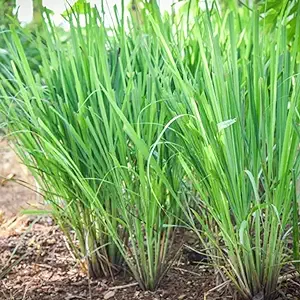10 Plants That Keep Ticks Away
Post Disclaimer
We may earn a commission for purchases made using our links. Please see our Disclaimer to learn more.
Tick-Free Zone: Plants That Keep Ticks Out of Your Yard
What are the 10 plants that can help keep ticks out of your yard?
Plants that can help keep ticks out of your yard are lavender, chrysanthemums, mint, rosemary, and marigolds. These plants have natural properties that repel ticks due to their strong scents or toxic compounds that ticks avoid. Planting these around your yard can act as a natural barrier against ticks.
Key Highlights
- Tick-repellent plants can create a natural barrier against ticks and help your yard from these diseases.
- Plants like lavender, garlic, rosemary, mint, chrysanthemums, marigold, lemongrass geranium, eucalyptus, and basil have natural properties that repel ticks.
- These plants work by emitting strong scents or producing chemical compounds that ticks find repulsive.
- Tick-repellent plants can also deter the animals that tick rely on for transportation and hosting, such as mice and deer.
- By strategically planting these tick-repellent plants in your yard, you can create a tick-free environment for you and your furry friends.
Introduction
Blood-sucking pests, like mosquitoes, bed bugs, and ticks, can be annoying. Pose health risks. Ticks, in particular, are known for spreading diseases such as Lyme disease and Rocky Mountain spotted fever. To protect yourself, consider planting plants that repel ticks. These natural deterrents help keep ticks away, ensuring a space. Explore the ten plants in this blog to maintain a tick yard and give yourself peace of mind. One interesting fact is that ticks start off disease-free but can pick up diseases from their blood meals. The primary carriers of tick-borne diseases are mammals like field mice, chipmunks, and shrews, whose populations can be controlled by removing their hiding spots in your yard. This proactive approach helps prevent the multiplication of ticks and the diseases they carry. Additionally, reducing food sources for these animals – such as bird feeders or oak trees – can also assist in reducing their numbers by decreasing carbon dioxide levels. Despite these precautions, it’s important to stay alert and prepared as encounters with ticks may still happen unexpectedly and seem like scenes out of a movie.
By planting plants that repel ticks and using nematodes, you can introduce helpful bacteria that target and eradicate these pests, turning them into lifeless nuisances that no longer threaten your garden.
Plants That Naturally Repel Ticks in Your Yard
Planting plants that repel ticks in your garden can keep these bugs at bay. Here are plants that can naturally deter ticks and help protect your area: lavender, Garlic, Rosemary, Mint, Chrysanthemums, Marigold, Lemongrass, Geranium, Eucalyptus, and Basil. These plants give off a scent or release chemicals that ticks dislike. By placing these tick-repelling plants in your garden, you can establish a defense against ticks and lower the chances of getting bitten by them.
1. Lavender
Lavender isn’t just an aromatic plant; it also boasts tick-repelling qualities. The potent aroma of lavender is renowned for warding off ticks, making it a great choice for your garden. Thriving in spots with drained soil, lavender is adaptable to various climates. You can grow lavender in plants or groups to form a barrier against ticks. Moreover, you can collect the flowers to create DIY tick repellents or sachets to scatter around your property. Lavender is a low-maintenance plant that enhances the beauty and scent of your garden and helps keep ticks. It’s a simple method to protect your outdoor space.
2. Garlic
Garlic is a kitchen ingredient and a natural way to keep ticks at bay. The aroma of garlic repels ticks, making it an effective deterrent when grown in your garden. Garlic also serves as a natural insect repellent. It can help ward off pests in your garden. Besides deterring ticks, garlic can also assist in keeping mosquitoes and other insects away. Planting garlic in your garden does not help safeguard against ticks. Also provides you with a fresh and flavorful cooking ingredient. It’s worth noting that while garlic helps repel ticks, it might also discourage insects such as bees and butterflies. To minimize any impact on pollinators, consider planting garlic away from flower beds.
3. Rosemary
Rosemary, a used herb in cooking, is also known for its ability to repel ticks due to its distinctive scent. Planting rosemary in your garden is a way to keep ticks away. It thrives best in areas with drained soil and can adapt well to weather conditions that suit various climates. Besides deterring ticks, rosemary is a repellent for pests like mosquitoes and fleas. Furthermore, deer are not fond of the smell of rosemary, which adds to its appeal. Growing rosemary in your yard lets you enjoy its fragrance and helps protect against ticks.
4. Mint
Mint is a herb commonly used in cooking. It also serves as a natural deterrent for ticks. The potent essential oils in mint plants effectively ward off ticks. The strong aroma of mint is repugnant to ticks, making it an ideal choice for your space. Consider planting mint near bird feeders or in areas you frequent outdoors to establish a tick environment. Remember that mint spreads rapidly, so it’s advisable to plant it in containers or use barriers to manage its growth. You can savor its invigorating scent by introducing mint into your garden while keeping those ticks at bay.
5. Chrysanthemums
Chrysanthemums are not just flowers. They also serve as natural repellents against ticks. These blooms contain an insecticide known as pyrethrin, which effectively deters insects, ticks included. Planting chrysanthemums in your garden can help establish a shield against these pests. These resilient perennials bloom during autumn, adding color to your space. Chrysanthemums are easy-to-care-for plants that thrive in sunlight and drained soil. By incorporating chrysanthemums into your landscape, you not only get to enjoy their flowers but also benefit from their tick-repelling properties at no cost. It’s worth mentioning that some individuals may have allergies to chrysanthemums, so it’s advisable to take precautions if you or your loved ones are allergy-prone.
6. Marigold
Marigolds are more than flowers. They also serve as effective natural repellents against ticks. With their scent, these flowers deter ticks and other pests effectively. Growing marigolds from seeds is a process that makes them suitable for both flower beds and containers. Being annuals, they complete their life cycle within a year. Often, they leave behind seeds that can sprout in the year. By planting marigolds in your garden, you create a shield against ticks and enhance the visual appeal of your outdoor area. Many gardeners favor marigolds for tick-repelling plants due to their reliability. Whether opting for the orange variety or exploring types, these blooms bring charm and functionality to any tick-free garden space.
7. Lemongrass
Lemongrass is an herb that serves well in the kitchen and repels ticks. With its lemony aroma, this plant tends to deter ticks due to its scent, making it quite effective in keeping them. The presence of citronella oil in lemongrass, an ingredient in tick repellents, further enhances its efficacy. To use its tick-repelling properties, consider planting lemongrass in your garden. Remember that lemongrass thrives best in tropical climates and may struggle to survive in colder regions. To ensure its survival during winter, try growing lemongrass in pots that can be moved indoors when needed. Growing lemongrass is relatively straightforward; it needs sunlight, regular watering, and drained soil. Introducing lemongrass into your space can create an environment from ticks while enjoying its refreshing fragrance.
8. Geranium
Geraniums are not just flowers. They also serve as a deterrent for ticks. These blooming plants give off a fragrance that ticks dislike, forming a shield against these pests. Geraniums can be grown in flower beds, pots, or hanging baskets. They thrive in sunlight to shade and drained soil. With geraniums in hues, you can inject color into your garden while keeping ticks away. It’s worth noting that geraniums tend to spread rapidly, so regular trimming and care may be necessary to prevent them from taking over your garden. You can display pots filled with tick-repelling beauty by incorporating geraniums into your area.
9. Eucalyptus
Eucalyptus, a tree known for its fragrance and natural tick-repelling properties, contains oils in its leaves that deter ticks and other insects. Consider planting eucalyptus trees or shrubs in your garden to keep your surroundings free of ticks. While native to Australia, these trees can thrive in regions, including the United States, as long as they receive ample sunlight and are planted in well-drained soil. Remember that eucalyptus trees can grow quite large, so assessing the space in your yard before planting them is wise. Furthermore, eucalyptus trees attract birds that prey on ticks, providing an added defense against these pests. Introducing eucalyptus into your space repels ticks and creates a welcoming environment for tick-eating birds.
10. Basil
Basil is a loved herb in the kitchen. Also serves as a natural tick repellent. Its powerful aroma effectively deters ticks, making it a great choice for your garden. Growing basil is simple. It can be done in pots or flower beds needing sunlight and good drainage. There are types of basil, like basil, lemon basil, and cinnamon basil, each with its own distinct scent. Planting basil in your garden does not add flavor to your dishes. Also helps keep ticks at bay. Remember that basil doesn’t like weather, so it’s best to plant it after the frost in your region. Whether on the East Coast or elsewhere, incorporating basil into your yard can help create a tick environment.
Understanding How Tick-Repellent Plants Work
Plants that repel ticks function in two ways to ward off these pests. Initially, they emit natural chemical compounds that serve as a defense mechanism for discouraging ticks and other insects. These compounds consist of oils. Potent fragrances that repel ticks effectively. Secondly, these tick-repelling plants can create an environment for the animals that the tick depends on for transportation and hosting, such as mice and deer. By deterring these animal hosts, tick-repellent plants help minimize the risk of tick infestations in your yard and the spread of diseases like Lyme disease. Understanding how these plants operate provides insight for making decisions on safeguarding your yard against ticks.
Natural Oils and Their Tick-Repelling Properties
Tick-repelling plants produce oils that possess properties to repel ticks. These oils emit an aroma in the plant’s leaves, stems, or flowers. Upon contact with these oils, ticks are. Discouraged from approaching. Certain plants known for their tick-repelling qualities, such as lemongrass and basil, contain oils utilized in tick repellents. These essential oils can be extracted from the plants and employed as a method of tick repellency. Moreover, repellent plants, such as the Earth, can carry substances that repel ticks. Combining these oils with carriers allows you to develop effective tick repellents that are safe for you and your outdoor space.
The Role of Aromatic Plants in Tick Control
Ticks can be effectively managed by using plants that release chemicals to deter them. These chemicals serve as a plant defense mechanism, discouraging animals from feeding on them. Although ticks typically do not feed on plants directly, the chemical compounds emitted by these plants can repel ticks. Prevent them from coming close. Planting plants around your property can establish a protective barrier that keeps ticks at bay. These plants essentially function as a shield, making it challenging for ticks to approach them for biting. Incorporating tick-repellent plants into your garden can greatly decrease the chances of tick bites and transmitting tick-borne illnesses.
Incorporating Tick-Repellent Plants into Your Landscape
Adding plants that repel ticks to your garden helps control ticks and enhances the beauty and practicality of your space. There are ways to incorporate these plants into your yard effectively. One approach is to create areas or borders dedicated to tick-repellent plants. These plants are concentrated in spots, adding an appealing element to your landscape design. Another useful technique is companion planting, where you strategically place tick-repellent plants alongside vegetation to boost their tick-repelling properties.
Design Ideas for a Tick-Free Garden
When designing a tick-free garden, it is important to consider aesthetics and functionality. One design idea is to create tick-repellent plant beds or borders using cardboard rolls from paper towels or toilet paper and an aluminum cooking pan. These designated areas can be filled with tick-repellent plants such as rosemary, wormwood, and lavender, with dosed cotton balls from a bag placed inside the rolls to protect against attached ticks. To enhance the effectiveness of these plants, you can also place dosed cotton balls soaked in tick-repellent essential oils among the plants. This provides an additional layer of protection against ticks. Another design idea is creating disjunct tick-repellent plant populations throughout your yard. By strategically placing these plants in different areas with a coarse weave, dosed cotton balls in cardboard tubes, and a bottle of permethrin insecticide, you create multiple barriers that make it difficult for ticks to access your outdoor space, covering the entire area.
Companion Planting Strategies
Companion planting proves to be a method for boosting the effectiveness of plants that repel ticks. You can establish a defense system that wards off ticks by placing these tick deterrents alongside other plants. One beneficial approach involves planting tick-repellent plants that attract insects and animals. These friendly bugs, like ladybugs and lacewings, feast on ticks, aiding in controlling their numbers. Another tactic is to position tick-repellent plants near those that deter the animals ticks depend on for survival. For instance, placing these plants close to ones that repel mice and deer. Two natural enemies of ticks. It can make your yard less inviting to these creatures, reducing the risk of tick infestations.
Maintenance Tips for Tick-Repellent Plants
Tick-repelling plants need some care to make sure they work well in keeping ticks. One key part of taking care of them is watering. These plants are like soil that drains well. It’s essential to water them regularly without overdoing it. It’s also important to consider their soil preferences, as tick-repelling plants have soil needs. Researching and understanding the requirements of each plant is crucial. Your tick-repelling plants can be protected by water and soil conditions can be ensured. Effectively keep ticks at bay.
Watering and Soil Preferences
When you’re watering plants that repel ticks, it’s crucial to find the balance. These plants typically do best in soil that drains well, so it’s important to water them not much. Giving them water can cause their roots to rot and create other problems. It’s also essential to consider the soil preferences of tick-repellent plants. Some plants, like rosemary and lavender, prefer loamy soil, while others, such as mint and geranium, thrive in soil. Providing the soil conditions will help these plants grow well and effectively fend off ticks. Moreover, planting tick-repellent plants close to those that attract predators, like ladybugs and lacewings, can establish a balanced ecosystem that helps control tick populations.
Pruning and Harvesting Tips
Maintaining tick-repellent plants involves pruning and harvesting, which are essential for their upkeep. Pruning preserves the plant’s vitality and form while stimulating growth. Trick away any diseased branches and maintain a balanced shape when pruning these plants. Harvesting is equally important for plants like rosemary and mint with repellent uses. Using shears to cut stems just above a leaf set is vital during harvesting. This practice promotes growth, ensuring the plants stay robust and fruitful.
Conclusion
Adding plants that repel ticks to your garden not only enhances its beauty but also serves as a way to keep ticks at bay. Plants like lavender and eucalyptus release scents that deter ticks, making your outdoor areas safe and pleasant. Knowing how these plants function and properly caring for them is key to ensuring they effectively repel ticks. Placing these plants and following maintenance guidelines can create a tick zone for your loved ones and pets to enjoy in peace. Embrace the wonders of nature with these plants. Protect your yard from invasions.
Frequently Asked Questions
Can these plants repel other pests?
While these plants that repel ticks might also deter pests like mosquitoes, fleas, moths, or ants, it’s worth noting that their effectiveness can vary. The substances they produce could discourage a variety of pests. Predicting the exact impact of each pest is challenging. For instance, lemongrass is known to work against ticks. This is where citronella, a repellent, originates from. However, it’s important to recognize that each pest has its own preferences and sensitivities. Planting these tick-repelling plants might create an environment that’s not as attractive to pests, but it may not completely eliminate every pest in your yard. Trying out plant combinations and observing the outcomes can help you discover an effective solution for your pest issues.








